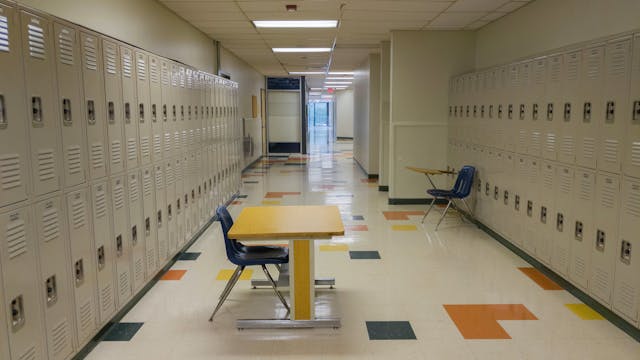Learning can happen anywhere — in a classroom, in a park, on a field trip or at a museum. But, the reality is that space matters.
I had a classroom last year, and while it was shared with my math counterpart, it was large and just for us. We taught lessons, organized student materials and met with families in this space. The other two special education teachers at my school also shared a classroom.
But when we returned this fall, we were told that we no longer had classrooms — they were needed elsewhere. This affected some of us more than others. Our special education team includes six teachers and four paraprofessionals, and we serve our students through a combination of models. We offer self-contained and behavioral support classes for students with significant exceptionalities, which some of us teach in designated classrooms that have remained intact. We also provide push-in and pull-out services for our students with mild to moderate learning needs, meaning that we teach them in a general education setting as well as pulling them out into a separate setting, which, this year, has become the hallway.
I teach 25 students a day, providing a combination of push-in and pull-out support. Teaching in the hall space is not only detrimental to their learning, it’s also degrading to me as a professional.
Pulling students out of their classroom to provide modified instruction was already challenging before space constraints became an issue. I typically work with small groups of seven to nine students with varying gaps in development. Coordinating schedules, tailoring lesson plans and constantly shifting my dyads and triads to ensure students are best placed with peers is no easy feat. Teaching in the hallway is incredibly problematic and has added to these challenges.
The constant movement of students and staff is very distracting for any student, let alone those with exceptionalities. There are too many visual and auditory distractions, with students and staff moving around, drawing the attention of my students away from their work. Equally problematic is the lack of access to resources and materials needed for lessons, such as Promethean Boards, dry erase boards and document cameras. We have no place to showcase our students' work, no place to create “cool down spaces” or work stations. And there’s the issue of privacy, which is key for my students. Most of them are doing foundational work, which is more than three grade levels below their assigned grade, and many of them feel vulnerable among their peers and feel uncomfortable having their learning needs on display.
The lack of urgency to resolve the issue has sent a message that the fact that there’s nowhere for us to go is not of great concern.
Our team tried to make this work for two months, but it wasn’t feasible. Students were annoyed and unnerved, teachers were frustrated. We were left with no choice but to go directly to the operations manager to make a plea for the resources we had last year and that we desperately needed — we wanted our classrooms and our teaching materials back.
We explained the time-sensitive, dire circumstances and we were met halfway. We repurposed a small office as a shared classroom and we were given a Promethean Board for the new space. It wasn’t ideal, but it was a step in the right direction.
We hoped our new makeshift classroom would be enough to solve our problems. We were excited, but it was short lived. The room was tiny, so students needed to sit still in tight spaces. And with multiple teachers and groups of students sharing the space, we were all competing for it. In the end, some of us were still pushed out into the hallway.
This has become a tense issue for our team and it has caused strife for our students. Losing our classrooms has been detrimental to academic learning and to our students’ social and emotional development. My students have expressed to me that they feel "othered." Many of them are already navigating deep feelings about their unique learning needs, being pulled out of their classrooms for tailored instruction or having push-in services when their peers are independently proficient.
In an effort to be solution-oriented, I have made use of other spaces, such as empty classrooms during planning periods and the media center, which is located on another floor but has a large, open space with most of the materials I need for instruction. These solutions may work intermittently, but they’re not permanent.
The harsh reality is that each time I've tried to find a solution, I’ve had to lug my students along with me to test it out, which has created constant change and disruption, when what my students need most is consistency. They should not have to endure this back and forth. Legally, they have a right to learn in their least restrictive environment, so having a designated learning space should be a top priority, yet sometimes it feels like this issue hasn’t even made the list.
Serving students with unique learning needs is a complex job that requires specific skills, resources and conditions to do effectively. One of those conditions is a safe, comfortable, consistent space to learn. As an advocate for my students, I will continue seeking a solution and putting pressure on the system, because teaching in a hallway is just plain insufficient.


